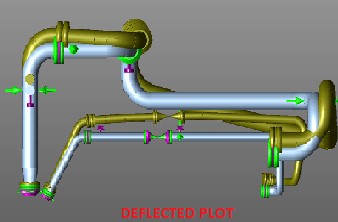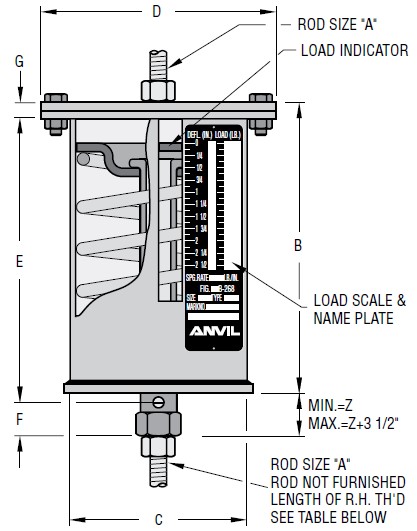1. Why to use a Spring Support
2. Types of Spring Supports
3. Terminology
4. Variable effort spring
5. Types of VES/CES
6. Selection of Variable effort spring
7. Constant effort spring
8. Selection of Constant effort spring
9. General notes and guidelines
10. Points to remember
11. Offshore applications
12. Spring vendors
1. Why to use a Spring Support?
- Any line operating at high temperature moves upwards/downwards (depending on the pipe configuration) due to thermal expansion. Any rigid support provided on such a line tends to lift pipe up/down and hence remain inactive during operating conditions. In such a case a flexible support (springs) is provided which is capable of taking the load in all the operating and cold conditions.
- The spring supports provides continuous support during expansion or contraction of the pipe.
- The spring support basically employs a spring element, which can get compressed or stretch-out depending upon the thermal movement of pipe and the corresponding loads.

Deflected plot
2. Types of Spring Supports
Depending on the loads to be accommodated and the magnitude & direction of the thermal displacement to be supported, spring supports are broadly classified as:
- Variable effort springs
- Constant effort springs
Some of the common terminology associated with the selection and procurement of any Springs are listed below:
-
- Cold Load
- Hot Load
- Spring Rate
- Spring Travel
- Load Variation or Variation
- Pre-compression Length
3. Terminology

Constant effort springs
- Cold Load: This refers to the load on the spring hanger when the system is in standby or non-operating condition.
- Hot Load: This refers to the actual load on the spring hanger during operating conditions
- Spring Rate/ Stifness: This refers to the spring rate, force per unit length in N/mm, kg/mm, etc. determined from flexibility analysis.
- Spring Travel: (Installed to operating): This refers to the maximum vertical movement of the spring due to piping loads at operating conditions determined from flexibility analysis.
- Load Variation or Variation: This refers to the allowed variations between the hot load and cold loads.

- Pre-Compression Length: It is the initial compressing of the spring for sustained load.
- Installation Height = loaded length – Pre-compression length

Installation height
4. Variable effort spring
-
- VES basically consist of a spring which can get compressed or expanded according to thermal movement of the pipe. However, this movement causes increase or decrease in supporting force depending on its stiffness & this differential load is transferred to the pipe
- This load is less than that would be with the rigid support.
- In VES load variation is maintained generally within 25%.
- In VES the loads increases with pipe movement.
5. Types of VES/CES
Hanger type: In hanger type spring support, the pipe is hung from the secondary support using hanger type spring, as shown. Clevis, Hanger rod, turn-buckle, pipe clamp, etc. are some other attachments associated with such a support.

Hanger type VES/CES
Bottom support type: In bottom support spring, the pipe is resting on the top of the spring load plate, as shown. This type of spring support is also known as ‘CAN’ Type or ‘F’ Type spring.
- Hanger type or bottom support type is selected based on pipe layout and the space availability for mounting.

Bottom support type
6. Selection of Variable effort spring
- Determine the required effort & pipe movement (up or down) from installed to operating condition.
- Select the smallest spring size from the vendor catalogue which has the operating load within the working travel.
- Ensure the spring selected can accommodate the preset to operating travel within the working range. This is done by moving up & down the chart from the operating load by the amount of travel.
- If the spring selected cannot accommodate the movement try a larger spring size or the next travel range.
- Check the variation in supporting effort for the selected spring.

- If this exceeds the allowable variation then choose the next travel range and go back to Step 3 above.
- If the variation is less than half of the allowable then a smaller travel range may be acceptable. Choose a smaller travel range and go back to step 4.
- If the variation exceeds the allowable selection then a constant effort support is required or possibility of routing changes to be studied.
Example:
Select a variable spring for the following conditions:
Hot load = 307 lbs, movement = ½” up, variability = 20% maximum
1. Calculate spring rate.
Spring rate = hot load x variability / movement
= 0.20*307/0.5 = 122.8 lbs per inch
2. Find the spring size column on the size and series selection chart where the hot load is 307 lbs.
(A size 5 series fig.82 fits the criteria)
3. Calculate the cold load.
![]()
Cold load = 307 + (63 x 0.50) = 339 lbs.
4. Now check to see if the hot load and cold load fit in the working range of size 5 series fig.82. If so, you have selected the proper unit.
7. Constant effort spring
- Whenever load variation exceeds 25% or exceeds the specified maximum load variation percentage in a variable hanger, then a Constant Effort Spring is selected.
- In CES the load remains constant when the pipe moves from its cold position to hot position. Thus irrespective of travel the load remains constant over complete range of movement.
- The pipe is supported by a drop rod connected via turnbuckle to the end of the lever arm.
- The spring coil applies a force to the trunnion arm of the lever which tends to pull the lever-arm UP against the load of the pipe.
- The geometry of the lever arm provides a balance btw the pipe load & spring force. The pipe may therefore move due to thermal expansion while being supported with a nominally constant force through this travel range.

8. Selection of Constant effort spring
-
- Determine the load to be supported by hanger as well as the actual travel, ie. The actual vertical movement of the pipe at the point of hanger location, refer load-travel table.
- The total travel for constant supports should be equal to “actual travel” plus 1” or 20% whichever is greater.
- After determining the size, consideration of available room for suspending the pipe and hanger will indicate whether a vertical or horizontal hanger is desirable.
- After hanger size & design are determined, the type of constant support to be used depends upon the physical installation required by the suspension problem.
- Example:
- Total travel = 4 “ and 2750 lbs
- Hanger size would be 34
9. General notes & guidelines
-
- Any re-adjustment of spring element shall be carried out only when the line is full with the fluid or its equivalent in density to balance the weight of piping and the preset load of spring.
- The adjustment of hanger type spring element is done by rotating turn buckle or adjustment nuts provided in the hanger rod.
- During hydraulic testing, flushing or chemical cleaning of the pipeline, the spring must be kept under locked condition or protected against overloading due to weight of testing / flushing fluid, by providing temporary.
- After re-adjustment it is important to check whether sufficient range is available on scale for required movement of the pipe during operation.
10. Points to remember
-
- Design spring based on the installation load (operating load).
- Compactness of the units. Installation heights designed to a minimum.
- During occasional case the pipe may move more than the operating movement. In such a case, if we choose maximum deflection range the spring cannot get further movement and thus the spring fails. To overcome such a problem provides “Cushion Range” means even if in occasional cases the spring may get compressed, so choose always “MID-RANGE”.
- Initial design itself the spring cannot be designed for occasional loads (e.g. Seismic, wind etc.) & movement then it may be an over design.
- For hanging spring support the lateral movements (rod swing) should not exceed 4 degree.
- For bottom type supports, where horizontal movement of more than ½” is envisaged, Teflon covered load pads should be specified.
- Always mention the hydro test load, while ordering a spring. This will help the spring vendor in designing the spring locking arrangement.
- Standard inventory finish: Hot dip galvanized.
- Coils come with a protective coating :
- Protects from a wide range of corrosives.
- Does not affect the flex life of the spring.
- Supports are fitted with nameplates marked with the installation and operating load, support reference mark, type and unique serial number.
11. Offshore applications
- Flow arm lines (X’mas tree to the production/ test manifolds).
- Compressors.
- WHRU (Waste Heat Recovery Units).
12. Spring vendors
- Sarathi
- Carpenter and paterson Ltd
- Lisega
- Anvil
- Bergen power
- Pipe support Ltd

Cool article, It was practical.
hoe we can calculate the pipe weight on pipe support
Hi Talal,
For Stress critical lines pipe loads are calculated based on stress analysis in Ceaser II software.